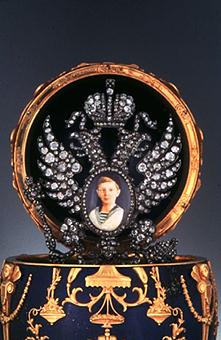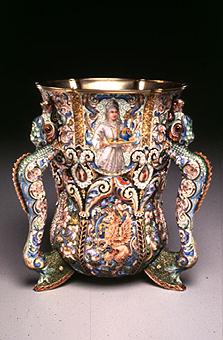|
LARGEST PUBLIC FABERGÉ COLLECTION WILL GO BACK ON VIEW IN RICHMOND The Virginia Museum of Fine Arts' world-renowned collection of Russian imperial Easter eggs by Peter Carl Faberge and other Russian decorative arts will be returned to view on Tuesday, July 20. The collection was removed from public display last summer for gallery renovation. The museum S collection of Faberge objects is one of the largest of any museum outside Russia. The new, thematically organized Faberge gallery will feature many recent gifts to the collection, as well as pieces that have been specially cleaned and restored to their original splendor. "As a signature holding of the Virginia Museum of Fine Arts, the Faberge collection, a gift of Lillian Thomas Pratt, is beloved by our visitors," says Virginia Museum of Fine Arts Director Katharine C. Lee.  Lapis Lazuli, gold, diamonds, Platinum or silver. (Detail) Egg Dim: 12,5x8,9 cm; Frame Dim 9,5 cm
The new gallery will showcase the full range of holdings bequeathed
to  (Rusian, 1846 - 1920). Rock crystal, enamel, gold, diamonds. Dim: 13,3x5,7 cm
Also on view in the new gallery will be an assortment of objects
at a child's eye-level for easier viewing by youngsters. "Our Faberge collection rewards scrutiny - these pieces are so densely layered with meaning," Curry says. "One can explore aesthetics, the history of art and architecture, political and social history, even shopping and collecting patterns within Faberge '5 glittering world." Master jeweler Peter Carl Faberge, the grandson of a French Huguenot who settled in Estonia, was born in St. Petersburg, where his father was a jeweler. After an apprenticeship in Frankfurt, he took over his father's shop and won a Gold Medal at the Pan-Russian exhibition in 1882. Alexander III was among those who attended the event and were intrigued by Faberge's objects of fantasy. Faberge was named goldsmith and jeweler to the Russian Court
in the mid- 1880s and proposed to Alexander III the creation
of an elaborate Easter egg to be presented to the Czarina. Alexander
was so taken by this first imperial egg that the special Easter
creations became a tradition throughout his reign and Of the 50 imperial eggs fashioned by Faberge, five have disappeared. The five in the Virginia Museum's Pratt Collection are all from Nicholas' reign. The eggs are witty and ingenious in their execution: each contains a "surprise" - a hidden mechanical device, a secret object, or concealed pictures. 
The museum's earliest, the Rock Crystal Egg, is perhaps the most spectacular. Presented to the Czarina in 1896, the year of Nicholas' coronation, it stands 10 inches tall. The delicate egg, carved from clear rock crystal, contains 12 tiny paintings of places that held special memories for the last czar and czarina. The egg is encircled by a band of green enamel set with diamonds and is crowned by a 26-carat Siberian cabochon emerald. The pedestal is made of gold and rock crystal. Its "surprise" is that the emerald, when depressed, engages a hook that revolves the miniatures. The Pratt Collection also includes the 1897 Pelican Egg, the
1903 Peter the Great Egg, the 1912 Czarevitch Egg, and the 1915
Red Cross Egg. Three years after the presentation of the Red
Cross Egg, Nicholas and his family were assassinated by Bolshevik
revolutionaries in a Siberian basement. |